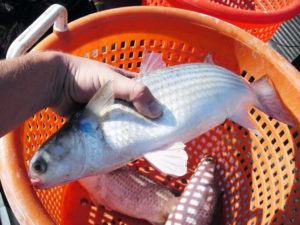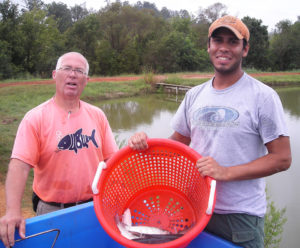Species shows compatibility with shrimp

For the past decade, Pacific white shrimp (Litopeneaus vannamei) have been successfully cultured in inland low-salinity waters in west-central Alabama, USA. More recently, striped mullet (Mugil cephalus) have been introduced as a potential polyculture species.
Following field trails demonstrating acclimation survival, shrimp compatibility and low-density culture, the potential of raising striped mullet with Pacific white shrimp looks promising.
Inland origin
The success of marine shrimp culture was first demonstrated by a few intrepid channel catfish producers in west-central Alabama back in 1999. All of the inland shrimp culture in Alabama occurs in central Greene County because of a low-salinity aquifer that yields salinities of 4 to 6 ppt. The water lacks sufficient potassium and magnesium, however requiring applications of muriate of potash and potassium magnesium.
There are approximately 40.5 hectaares of inland shrimp ponds in Alabama. Production is typically in the range of 2,800-3,925 kg/ha. Alabama farm-raised shrimp are marketed nationally via high-end supermarket chains, and some producers market exclusively on the farm.
Practical polyculture
The primary author was introduced to the concept of practical polyculture by aquaculture pioneer Daniel K. Butterfield. Butterfield practiced polyculture on his large Alabama farm for over 30 years. Although the co-culture of striped mullet and Pacific white shrimp isn’t perfect – both species basically share the same detrivoric trophic level – it did appear promising if striped mullet were introduced as a low-density addition to the system.
Making the concept more feasible was the willingness of the farm’s owners, Drs. David Teichert-Coddington and H. R. Schmittou. Schmittou, a highly recognized aquaculturist, documented in his earlier works the hatchery protocol of striped mullet in Southeast Asia.
Market-size mullet

Fingerling mullet were obtained in the wild from the coastal Gulf of Mexico waters of Alabama, for mullet hatcheries in the continental United States are nonexistent. Wild striped mullet proved to be a hardy species during acclimation. The next step was to determine compatibility and survival of mullet and shrimp when co-cultured.
Mullet weighing 30 times as much as the Pacific white shrimp postlarvae were grown together for 30 days. In a controlled experiment, the mullet/shrimp combination experienced the same survival rates as mullet and shrimp grown separately. However, it was noted that the mullet fingerlings readily consumed expensive shrimp feed. Fingerling mullet were then introduced to shrimp production ponds at very low densities of 50-74 animals/hectare.
The authors determined that the production of market-sized mullet weighing 0.9 to 1.4 kg was a two-year process. Fingerling mullet would grow to “stocker size,” 45 to 136 grams, the first year and then reach market size in the second year. Alabama’s typical shrimp production season is from early May to late September. Mullet were overwintered in production ponds without shrimp.
Future work needs to be conducted on increasing stocking rates to commercially viable levels. Given the current price of bulk-delivered shrimp feed (U.S. $730-820/metric ton) and a relatively low market price for striped mullet, just how much “detrivoring” is occurring must be determined.
The owners report that the mullet visibly respond to the presence of the feed truck. Intensive mullet culture outside the United States is practiced with artificial feeding.
Seedstock
In order for a mullet industry to get a foothold, dependable supplies of mullet fingerlings from commercial hatcheries will be needed. Mullet are fall spawners. This actually is a favorable situation on an inland shrimp farm, because indoor acclimation facilities could serve the dual functions of fry and fingerling production.
One drawback encountered with striped mullet was a relatively poor condition index for the market-size fish. Although roe formation is seen, the condition indexes for Alabama mullet were low based on scientific literature. Work on improving these indices is needed before an attempt is made to spawn mullet.
Harvesting
If higher-density culture is practiced, the harvest of farm-raised mullet may be an issue. Alabama shrimp are harvested by draining ponds and pumping shrimp into dewatering towers. Mullet fingerlings and stockers seem to endure this process without apparent harm. Larger food-size mullet tend to go upstream during shrimp harvest and have to be retrieved when they beach.
One solution may be using a selective mesh seine before the shrimp harvest. This would allow shrimp to grade through and retain the larger mullet. This practice of grading market-size fish is common at commercial catfish farms. However, mullet may be more prone to jumping over the nets. Aquaculturists with practical experience in harvesting mullets are encouraged to contact the primary author on this particular issue.
Marketing
Marketing to date has not been an issue. There seems to be a demand for farm-raised mullet. The farmed variety lacks the strong fishy taste common to their wild brethren. The researchers often have to rescue the mullet from the farm laborers during the shrimp harvest – at least until pertinent data have been recorded. The farm owners have remarked that their shrimp buyers are eager to explore the potential markets for U.S farm-raised mullet.
Perspectives
As a eurythermic and euryhaline species, striped mullet may be a potential commercial species for shrimp and catfish producers blessed with access to low-salinity water. Work still needs to be performed on the economic potential, broodstock conditioning and fingerling production of the fish. Until then, the dedicated staff at the Greene Prairie Aquafarm will keep on enjoying the tasteful attributes of U.S. farm-raised mullet provided by the relentless advances of extension aquaculture.
(Editor’s Note: This article was originally published in the July/October 2013 print edition of the Global Aquaculture Advocate.)
Authors
-
Gregory N. Whitis, M.Aq.
Alabama Fish Farming Center
Alabama Cooperative Extension System
529 South Centerville Street
Greensboro, Alabama 36744 USA -
Luke A. Roy, Ph.D.
University of Arkansas
Pine Bluff, Arkansas, USA -
David Teichert-Coddington, Ph.D.
Greene Prairie Aquafarm
Forkland, Alabama, USA
Tagged With
Related Posts

Innovation & Investment
Boutique fish farms in Brazil
In combination with the availability of coastal areas with favorable environmental and labor conditions, Brazil’s affluent market for seafood could support expansion of a niche aquaculture sector: boutique farming.

Responsibility
Egypt’s success with tilapia a blueprint for all Africa
Egypt is the third-largest tilapia producer globally, after China and Indonesia, and accounts for about 80 percent of African production of farmed tilapia. Many of the reasons for Egypt’s successful development of its important tilapia industry could be applied to the rest of African continent.

Health & Welfare
Study seeks candidates for blue shrimp polyculture in New Caledonia
Seasonal pathologies reduce the profitability and sustainability of the shrimp-farming industry in New Caledonia. A study was therefore conducted to estimate the effects of polyculture of blue shrimp with goldline rabbitfish or mullet on production performance and environmental quality.

Health & Welfare
A look at tilapia aquaculture in Ghana
Aquaculture in Ghana has overcome its historic fits and starts and is helping to narrow the gap between domestic seafood production and consumption. Production is based on Nile tilapia.


